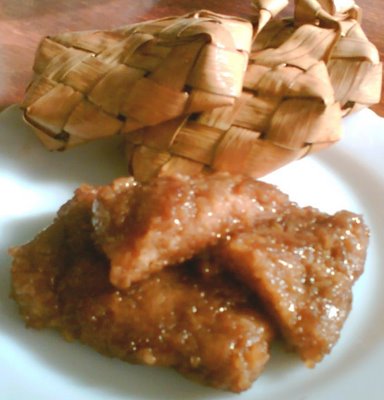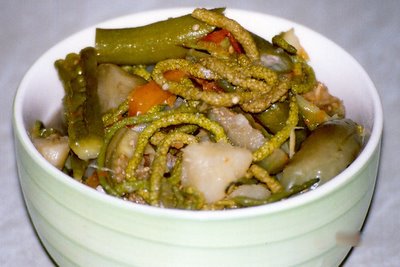
Related Posts

Related Posts
 Cafe By the Ruins, my most beloved Baguio restaurant, calls this simply vegetable omelet. It is a simple enough omelet - tender slices of blanched shiitake mushrooms and julienned boiled potatoes moistened by a little mayonnaise and some melted cheese, lovingly enclosed by perfectly scrambled eggs.
Cafe By the Ruins, my most beloved Baguio restaurant, calls this simply vegetable omelet. It is a simple enough omelet - tender slices of blanched shiitake mushrooms and julienned boiled potatoes moistened by a little mayonnaise and some melted cheese, lovingly enclosed by perfectly scrambled eggs.  It is one of my three favorite dishes the restaurant serves year-round that contain shiitake mushrooms (the other two being a delicious shrimp-sotanghon soup and forest stream soup), although they are seriously impaired when fresh shiitake mushrooms are not available in the Cordilleras (they never use dried shiitake). So I only order these three when it's shiitake season, which is right about just now, or cook some when I can't go to Baguio.
It is one of my three favorite dishes the restaurant serves year-round that contain shiitake mushrooms (the other two being a delicious shrimp-sotanghon soup and forest stream soup), although they are seriously impaired when fresh shiitake mushrooms are not available in the Cordilleras (they never use dried shiitake). So I only order these three when it's shiitake season, which is right about just now, or cook some when I can't go to Baguio. Other posts on food at Cafe by the Ruins:
Adobo sa Mangga
Shiitake-Watercress Soup
Lunch at Cafe by the Ruins

It is not favored, though, in my family. Probably because unripe papayas are held in such high esteem, while the sayote fruit, like the eggplant and other water-logged fruits, is dismissed as just containing water and not much else. And partly because it is so common and available. The leaves feel so rough to the tongue and are too chewy.
I'm trying to remedy that now that I am grown up and managing my own kitchen. I still haven't gotten over my childhood indifference to the fruit, though I try to have it as often as once a week in a tahong-halaan tinola. But it is the tops that I have quite developed a love affair with.
My sister, influenced by her in-laws, taught me a great dish using the young leaves. The tops, including the tendrils but with the tough bottom stalks removed, are sliced and sauteed with tomatoes, julienned potatoes and oyster mushrooms, and flavored with tiny shrimps. A little water is added for some broth, and for the stalks to soften in a little.

I have come to adore the green leafy taste of the dish, a bit peppery but with sweet hints, punctuated by the light sourness of the tomatoes and the earthiness of the mushrooms. The potatoes provide starchy, soft points to contrast to the leafy bites. Paired with a chop of teriyaki-glazed tuna belly, or any other grilled fatty fish, such as Bonuan bangus or salmon, it provides for a scrumptious and satisfying evening meal.

So when in Baguio buying sayote tops is a must for me. Of course after a healthy dose of Good Shepherd products. Dealers of Baguio vegetables in my hometown and in Dagupan City always stock up bundles of it, and I always see some in the vegetable crisper sections of major supermarkets in Metro Manila. However, these are, almost always, wilted or ready to wilt.
This is understandable, since they have undergone hours of traveling and being tossed here and there. They are quite sensitive, actually. Even in Baguio, those harvested in the morning and remain unsold in the afternoons are already droopy. This is true for most leafy vegetables, anyway. They don't travel well, and they really can't be stored, even in the refrigerator. Which brings the necessity of going to the market on the day you want to cook and eat them.

This is part of a series, "Tinapay," about local breads and cookies at street corner bakeries across the Philippines.

Note
You are more than welcome to buy after the Holy Week and for the rest of the year (you'd be more lucky in being able to snatch a bottle of that most-coveted ube jam), but be warned, though, Good Shepherd claims no responsibility for products sold under the Mountain Maid brand at outlets other than in the convent, whether in Baguio or elsewhere. So go to Baguio! And buy Good Shepherd, even if it is the only thing you bring home. Never mind the walis.
Emblazoned on every Good Shepherd jar and and plastic wrap is the statement that every product you buy helps the convent in sending someone to school. Do patronize Good Shepherd products. The premium you pay for first-rate quality food products and the effort to go to their store are more than worth it. You are also fulfilling your alms-giving duty this Lenten Season, at the same time satisfying your palate. Hitting two birds with one stone - a bit odd, since Lent is about fasting and abstinence, but that's just me, hehe.


 Paradoxically, though, however pretty the lattice design the casing imparts on the rice, the "skin" makes it hard to get to the sweet, sticky treat inside. You would need a sharp knife to cut the leaves, and by the time you've realized that you've already smeared your fingers with the brown syrup seeping out of the weave, and you likewise smear the knife, making it slick-difficult to handle. But you don't want to wash your hands. You want to lick them. Go on, nobody's looking. But there's still the slippery knife. You lick it, too, the handle, the blade, and so you cut your tongue...
Paradoxically, though, however pretty the lattice design the casing imparts on the rice, the "skin" makes it hard to get to the sweet, sticky treat inside. You would need a sharp knife to cut the leaves, and by the time you've realized that you've already smeared your fingers with the brown syrup seeping out of the weave, and you likewise smear the knife, making it slick-difficult to handle. But you don't want to wash your hands. You want to lick them. Go on, nobody's looking. But there's still the slippery knife. You lick it, too, the handle, the blade, and so you cut your tongue...

 And so before I ever set foot in Dipolog City in northwestern Mindanao, I have been enjoying for years the city's pride, Spanish style sardines made and sold under the Montaño brand.
And so before I ever set foot in Dipolog City in northwestern Mindanao, I have been enjoying for years the city's pride, Spanish style sardines made and sold under the Montaño brand.  Sometimes happiness is as simple as being able to buy a handful of baég (about 50 grams at Php10) to put in a pot of pakbet (pinakbet), or mix in a stew of balatóng (munggo, mung beans) sauteed with chopped, ripe tomatoes. It becomes a joy, really, because the tree, or more appropriately the woody, high-growing shrub, bears only seasonally these light-green, textured, long spindly flowers that turn into a vegetable for us Northerners (Ilocanos and Pangasinenses).
Sometimes happiness is as simple as being able to buy a handful of baég (about 50 grams at Php10) to put in a pot of pakbet (pinakbet), or mix in a stew of balatóng (munggo, mung beans) sauteed with chopped, ripe tomatoes. It becomes a joy, really, because the tree, or more appropriately the woody, high-growing shrub, bears only seasonally these light-green, textured, long spindly flowers that turn into a vegetable for us Northerners (Ilocanos and Pangasinenses). 


 Before gasoline stations became virtual malls there was Shell Tollway Plaza, with Shell Select the only outlet to sell food - foil-packed, bottled, canned - all trappings of a convenient store. But there was a shelf or two carrying local bakeshop goodies, probably from the nearest town, which was Malolos.
Before gasoline stations became virtual malls there was Shell Tollway Plaza, with Shell Select the only outlet to sell food - foil-packed, bottled, canned - all trappings of a convenient store. But there was a shelf or two carrying local bakeshop goodies, probably from the nearest town, which was Malolos. 


 Something for Lent. As a child I was given the roe from bulging fish cooked in sinigang - the traditional Filipino soup of fresh fish in clear sour broth. And it stuck - I've always given premium to fish roe, extending to fat squid thick with doughy filling. And I'm not referring to stuffed squid.
Something for Lent. As a child I was given the roe from bulging fish cooked in sinigang - the traditional Filipino soup of fresh fish in clear sour broth. And it stuck - I've always given premium to fish roe, extending to fat squid thick with doughy filling. And I'm not referring to stuffed squid.  At the Panamian food stall at last year's DFA International Bazaar was a cold dessert in a cup called arroz tres leches, or rice with three kinds of milk. It was one of several Panamian food offerings which were locally cooked/made, and mostly involved rice.
At the Panamian food stall at last year's DFA International Bazaar was a cold dessert in a cup called arroz tres leches, or rice with three kinds of milk. It was one of several Panamian food offerings which were locally cooked/made, and mostly involved rice.  I'm having such a grand ball with the can of Old Bay Seasoning sent to me by Cathy for the BBM4 food swap. Several recipes have been printed at the back and on the side of the can, and I've already tried several, to great results.
I'm having such a grand ball with the can of Old Bay Seasoning sent to me by Cathy for the BBM4 food swap. Several recipes have been printed at the back and on the side of the can, and I've already tried several, to great results. Crab cakes used a pound of crab meat, two tablespoons of mayonnaise, a teaspoon of mustard, two slices of bread (the one available in the house was whole wheat) which had been flaked without the edges, a tablespoon of the seasoning, some ground pepper, and a beaten egg. All the ingredients are mixed together, shaped into patties and shallow-fried on both sides.
Crab cakes used a pound of crab meat, two tablespoons of mayonnaise, a teaspoon of mustard, two slices of bread (the one available in the house was whole wheat) which had been flaked without the edges, a tablespoon of the seasoning, some ground pepper, and a beaten egg. All the ingredients are mixed together, shaped into patties and shallow-fried on both sides.  Whenever I visit a new place, the first things I do are, first, visit the local parish church (Roman Catholic), to say a prayer of thanks for a safe journey. And second, go to the street corner bakery to peruse the various local breads and pastries on display. And in most probability buy some samples, especially those which look unfamiliar to me, to refresh me after a tiring trip.
Whenever I visit a new place, the first things I do are, first, visit the local parish church (Roman Catholic), to say a prayer of thanks for a safe journey. And second, go to the street corner bakery to peruse the various local breads and pastries on display. And in most probability buy some samples, especially those which look unfamiliar to me, to refresh me after a tiring trip.  And then all pretensions are stripped off, exposing all secrets. The bread is now alembong, wanton, a coquette.
And then all pretensions are stripped off, exposing all secrets. The bread is now alembong, wanton, a coquette. *Update: Other names for this bread in other areas include bellas (Marikina), pan de pula, floor wax, pan de red around Metro Manila, pam-pam (Bacolod), and balintawak in Pangasinan.